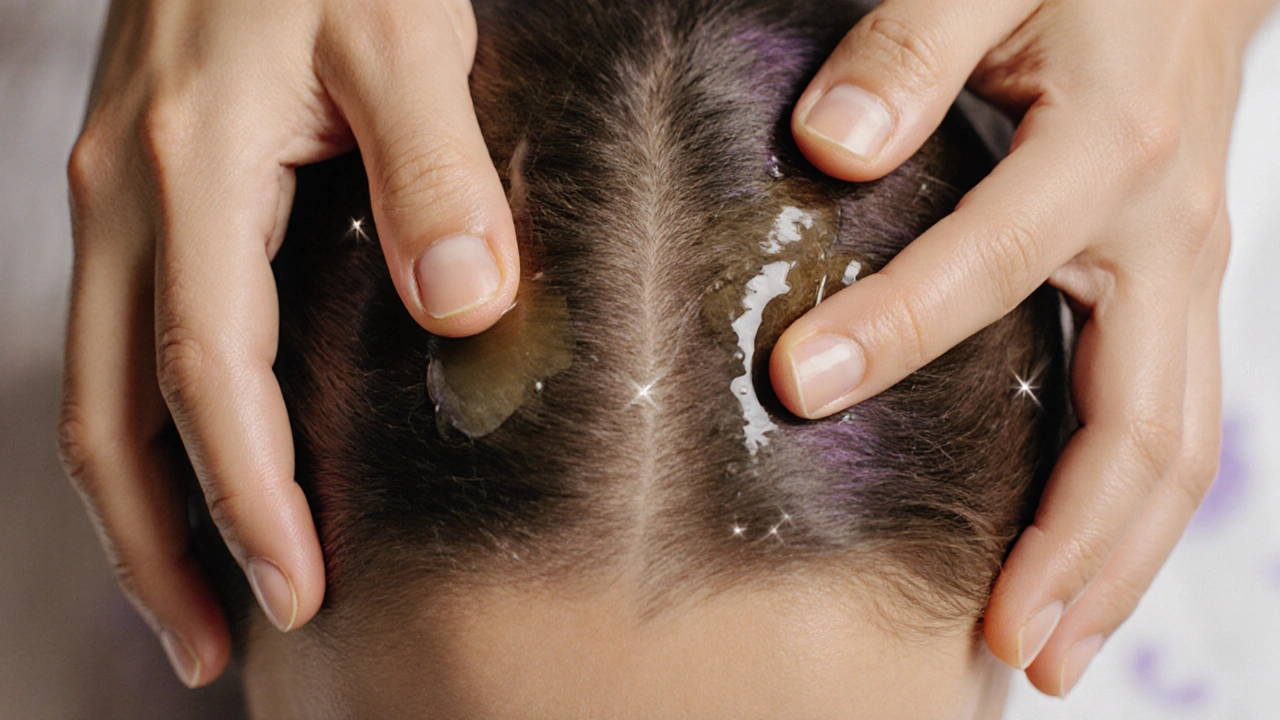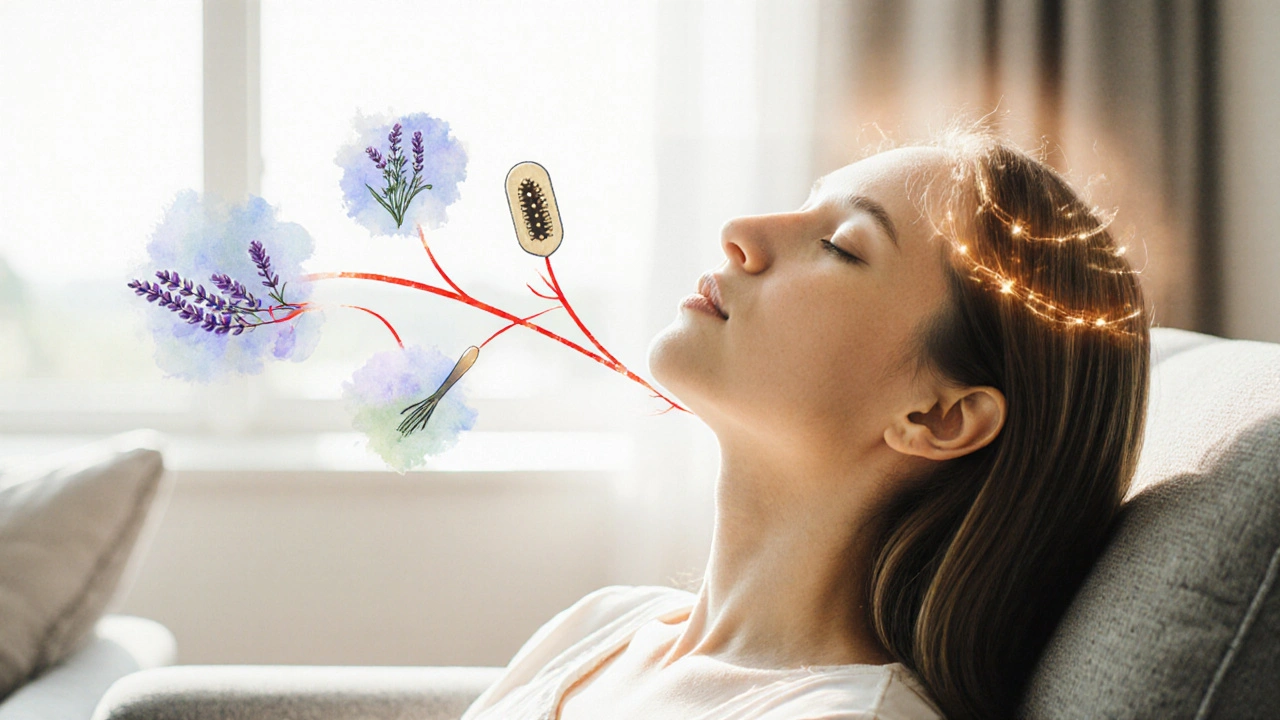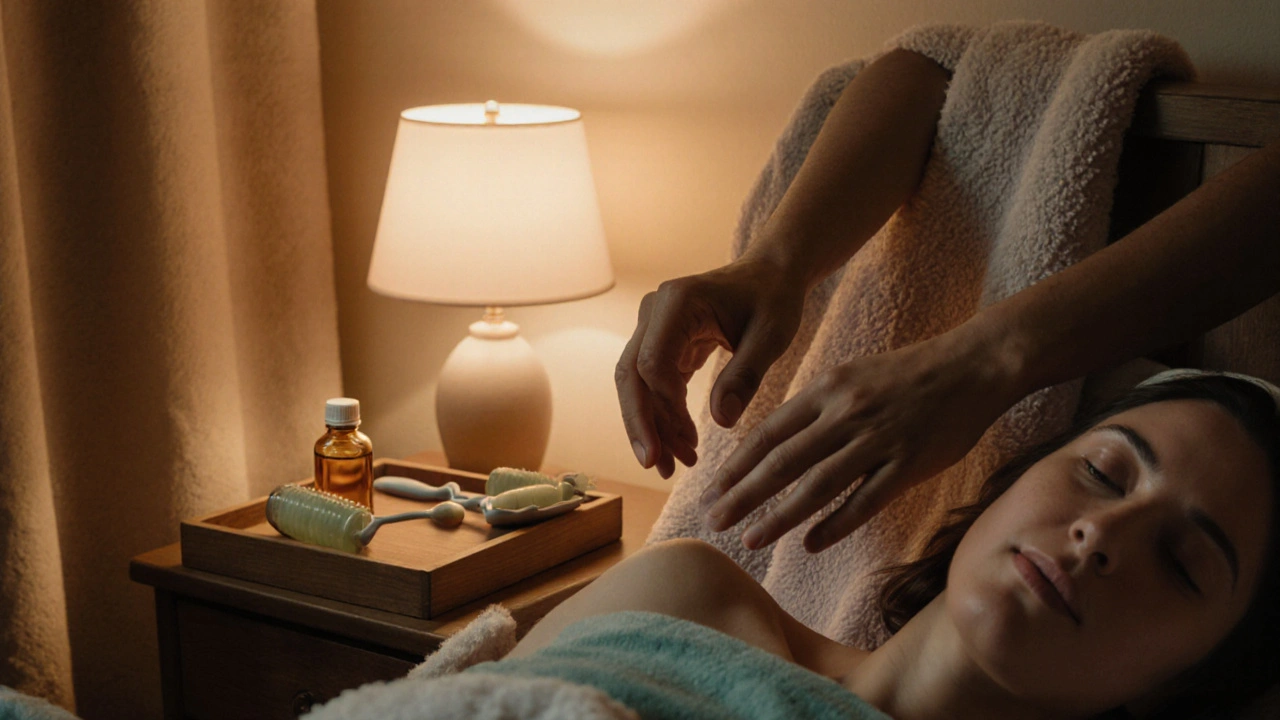Head & Scalp Massage Timer
Step 1: Prepare the Space
Dim lights, play soothing music, and set a comfortable temperature.
Duration: 30 secondsStep 2: Apply Oil (Optional)
Warm a small amount of your chosen oil between your palms and spread lightly over the scalp.
Duration: 30 secondsStep 3: Temples
Using gentle circular motions with your fingertips, massage each temple for 20 seconds.
Duration: 20 secondsStep 4: Crown
With the palm of your hand, apply a broader, gliding stroke from the front hairline toward the occipital ridge. Repeat 3 times.
Duration: 30 secondsStep 5: Base of Skull
Use your thumbs to press into the suboccipital area in small circles for 30 seconds.
Duration: 30 secondsStep 6: Final Brush
Run a soft brush gently from back to front to stimulate nerves and finish with a tingling sensation.
Duration: 30 secondsQuick Takeaways
- Head and scalp massage improves blood flow, reduces tension headaches, and promotes hair health.
- You only need a few minutes and simple tools like fingertips, a soft brush, or a handheld roller.
- Follow a 5‑step routine to maximize relaxation and avoid common mistakes.
- Essential oils such as lavender or tea tree add soothing aroma and skin benefits.
- DIY at home offers flexibility, while a professional session provides deeper muscle work.
If you’re looking to unwind, a head and scalp massage can work wonders. In today’s fast‑paced world, the simple act of kneading the scalp can melt stress, boost circulation, and leave you feeling refreshed in just a few minutes.
Head and scalp massage is a relaxation technique that focuses on the skin, muscles, and nerves covering the skull. By applying gentle pressure with fingers, a brush, or a roller, the practice stimulates the scalp and underlying tissues, encouraging a cascade of physical and mental benefits.
Why It Works: The Benefits
Understanding the science behind the practice helps you appreciate its impact. Here are the main advantages backed by research and practitioner experience:
- Improved blood circulation - Light pressure dilates capillaries, delivering oxygen and nutrients to hair follicles.
- Reduced tension headaches - Massaging trigger points eases muscle tightness that often triggers frontal or occipital pain.
- Lymphatic drainage - Gentle strokes help move lymph fluid, decreasing puffiness and supporting immune function.
- Stress relief - The rhythmic motion triggers the parasympathetic nervous system, lowering cortisol levels.
- Hair health - Better blood flow and oil distribution can improve shine and reduce breakage.

Essential Tools & Ingredients
You don’t need a fancy spa setup. Most people have everything at home. Choose the tool that feels most comfortable for you:
- Fingertips - The most direct method; use thumbs or the pads of your fingers.
- Soft brush - A boar‑bristle or silicone brush works well for a light, tingling sensation.
- Handheld roller - Small, battery‑operated rollers can reach the crown without straining your arms.
Adding essential oils further enhances relaxation. Lavender (calming), peppermint (invigorating), and tea tree (antimicrobial) are popular choices. Dilute a few drops in a carrier oil like jojoba or sweet almond before applying.
Step‑by‑Step Routine (5 Minutes)
- Prepare the space. Dim lights, play soothing music, and set a comfortable temperature.
- Apply oil (optional). Warm a small amount of your chosen oil between your palms and spread lightly over the scalp.
- Start at the temples. Using gentle circular motions with your fingertips, massage each temple for 20 seconds. This eases the frontalis muscle.
- Move to the crown. With the palm of your hand, apply a broader, gliding stroke from the front hairline toward the occipital ridge. Repeat 3 times.
- Target the base of the skull. Use your thumbs to press into the suboccipital area (just above the neck) in small circles for 30 seconds. This spot often stores tension from screen time.
- Finish with a light scalp brush. Run the brush gently from back to front, letting the bristles stimulate the nerves for a final tingling finish.
Adjust pressure based on comfort - never force pain. The whole sequence should feel soothing, not strenuous.
Pro Tips & Common Mistakes
- Consistency beats intensity. A 3‑minute session daily is more effective than a 20‑minute marathon once a month.
- Mind the nails. Keep fingernails trimmed to avoid scratching the scalp.
- Avoid excessive oil. Too much can make hair greasy; a few drops are enough.
- Stay hydrated. Water helps flush out toxins released during massage.
- Don’t skip the neck. The muscles that attach to the base of the skull often hold the most tension.

DIY at Home vs. Professional Session
| Aspect | DIY (Home) | Professional (Spa) |
|---|---|---|
| Cost | Low (oil, brush) | Higher (session fee) |
| Time Commitment | 5‑10min daily | 30‑60min per visit |
| Depth of Pressure | Light‑to‑moderate | Can reach deeper muscle layers |
| Customization | Self‑adjustable | Therapist tailors technique |
| Learning Curve | Easy to start | Therapist brings expertise |
If you’re short on time or budget, the DIY method delivers solid stress relief. When you need deeper muscle work or have chronic tension, booking a therapist can provide a more intensive experience.
Frequently Asked Questions
How often should I do a head and scalp massage?
For most people, a short 3‑5minute session once or twice a day is enough to keep tension at bay and support circulation.
Can I use a hair dryer after the massage?
It’s best to let the scalp air‑dry for a few minutes. Heat can close pores and reduce the soothing effect of the oils.
Is scalp massage safe for people with hair loss?
Gentle massage can actually stimulate follicles and improve blood flow, which may help slow thinning. Avoid aggressive pulling if the scalp is sensitive.
What essential oil blends work best for relaxation?
A mix of 3drops lavender, 2drops bergamot, and 1drop chamomile in a teaspoon of carrier oil offers a calm, citrusy aroma without overwhelming the senses.
Should I massage my scalp if I have a skin condition like psoriasis?
Consult a dermatologist first. Light, non‑scratching strokes are generally safe, but avoid friction that could flare lesions.
Next Steps & Troubleshooting
If you finish the routine and still feel tight, try these adjustments:
- Increase duration. Add an extra minute to the occipital area.
- Warm your hands. Warm palms before starting to deepen muscle relaxation.
- Combine with breathing. Inhale deeply through the nose, exhale through the mouth while massaging to enhance the parasympathetic response.
- Check posture. Sit upright with shoulders relaxed; slouching transfers tension back to the neck.
Remember, the goal is to create a pleasant habit, not a painful workout. Over time, you’ll notice fewer headaches, shinier hair, and a calmer mind - all from a few minutes of mindful pressure on your scalp.
